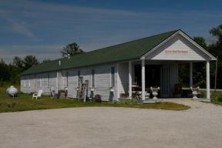Island Players: A Costumer’s View
- Share
- Tweet
- Pin
- Share
Costuming an Island Players (IP) production is always a great adventure. The costume crew is challenged to find garments and accessories that create the right look for the mood and period of the play, as well as fitting the actors, who come in a wide variety of sizes and shapes. For contemporary plays such as Almost, Maine, which Island Players produced this summer, this is not so difficult – most of the costumes were standard Door County winter garb. But as we go back in time, things become chancier. Our 2013 winter production, Pygmalion, for example, was set in 1912 London, so the question became, “How closely can/should we recreate the styles of the period? Do we want to be accurate, or simply suggest?”
In working on Pygmalion, not least of the problems we encountered was overcoming the elegant, elaborate images we all remember from the film My Fair Lady, Hollywood’s musical version of the play. Needless to say, our budget did not permit such an extravaganza! As it turned out, finding costumes appropriate for the common folk was not too difficult. Although jeans and denim jackets were not acceptable, we found a boxy canvas barn coat for Alfie Doolittle that suited his trade of dustman (“garbage man” in American parlance). Paired with a well-worn leather vest, checked shirt, and neckerchief, it gave a timeless workingman’s look.
A greater problem was dressing the “swells” – women in their beautiful gowns and men in frock coats and silk top hats. As reference for Edwardian styles, we had both the Internet and Downton Abbey, but BBC’s costume budget was just as out of reach for us as Hollywood’s. A compromise between period authenticity and limited funds was called for. The search began: some elements came out of actors’ own wardrobes, one or two emerged from the IP costume collection itself and a few pieces were even found in costume crew members’ closets. In the end, we purchased fabric and made several dresses. But the distinctive style that said “1912” best, was huge, elaborate women’s hats, so we created hats with filmy fabric, feathers, silk flowers, and glue guns. It worked. Audiences noticed the hats, not anomalous details such as modern tuxedos or non-period shoes.
The costuming process begins when rehearsals do, as the costume crew interviews and measures each actor. On the grounds that their own clothes (especially shoes) will fit best and be most comfortable, actors are encouraged to look first to their own closets. Failing that, the crew checks out the IP costume collection. Then the search may expand into our own and our neighbors’ closets, to the Door County Costume Collective in Sturgeon Bay and even to area resale shops.

Howard Scott shows off his elaborate costume for ‘Moon Over Buffalo.’
On occasion, IP has also borrowed or rented costume elements from other theater groups who have produced the same show, such as the Artful Dodger’s hat and patchwork jacket in Oliver. And the considerable sewing talents of Islanders always come in handy to create and alter costumes. Occasionally, we have no choice but to purchase specialized costume elements, such as the men’s tights for I Hate Hamlet and a Cyrano nose for Moon Over Buffalo.
The final round of review and revision happens during “Tech Week” – the final week of rehearsals. At this point, the costume crew has two separate duties. First, they must make sure that everything goes properly backstage: that necessary costume elements are in place for smooth and quick changes, and that any actor needing help with a change has it. Second, crew members sit in the audience during the dress rehearsals, assessing the details of each costume and how it coordinates with other costumes in the same scene. This may mean adding jewelry or a scarf to brighten a scene, or exchanging a gray sweater for a red one. Or maybe cautioning an actor to get rid of the white socks – a no-no on stage!
During performances, costume crew members circulate backstage, alert to help with fast changes and ready in case of the dread “wardrobe malfunction!” In the end, after the curtain calls are over and the house lights dimmed, while costume crew members don’t take any bows, we get to bask a little at the edges of the limelight, with the satisfaction of knowing it all worked, and that we’ve contributed to another successful Island Players production.
About Island Players
Island Players is the community theater organization of Washington Island. With one paid staff member and dozens of community volunteers, we put on two major productions a year as well as a number of smaller events. A typical production involves 40 or more community members in the cast and crew, and represents hundreds of hours of volunteer labor, building sets, arranging sounds and lighting, assembling costumes, and finding props, in addition to the hours of rehearsal time on the part of the cast. IP has also sponsored a Dramatic Arts in Education program for the students in our K-12 school.
Judie Yamamoto has been costuming for IP for the past eight years. She is a weaver/fiber artist who lives year-round on the Island.
Peninsula Arts and Humanities Alliance, Inc., is a coalition of non-profit organizations whose purpose is to enhance, promote and advocate the arts, humanities and natural sciences in Door County.




